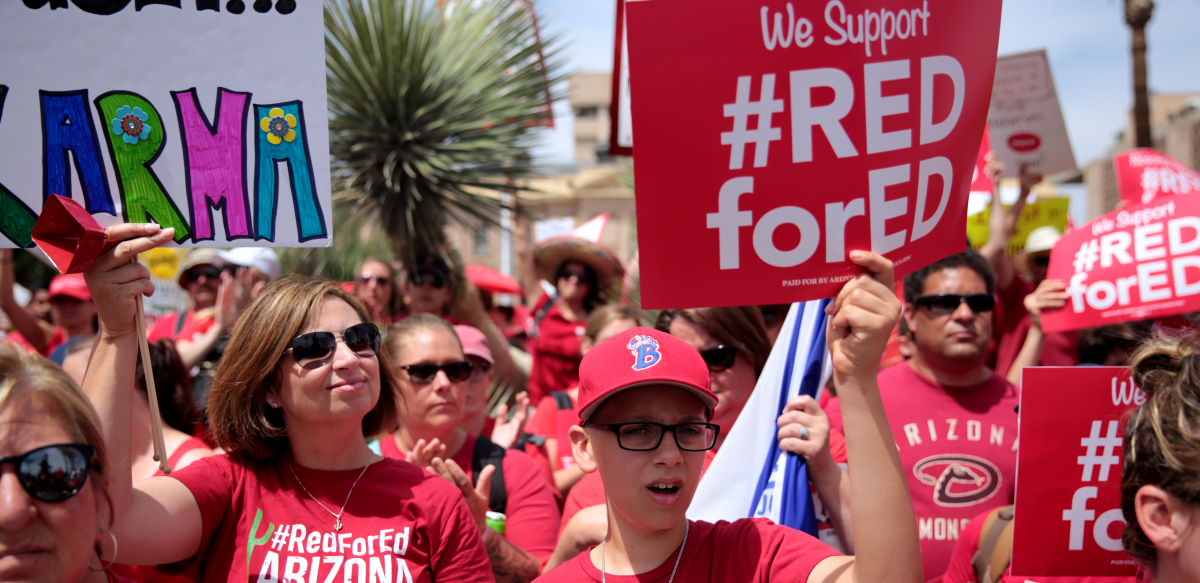Lessons from Teachers on How to Strike and Win

Teachers have put the strike—labor’s most powerful weapon—back in our playbook. Photo: Gage Skidmore, CC BY-SA 2.0, cropped from original.
Teachers across the country this year are breathing new life into the strike—galvanizing members and winning gains.
These strikes are fueled by rank-and-file anger. Many were coordinated not from above by the official union leadership but by networks of activists. The size of the mobilizations and level of organization have caught many by surprise.
The teachers have put the strike—labor’s most powerful weapon—back in our playbook. They’re showing what can be done when workers unite, organize creatively, and take to the streets.
Teachers have wiped away some of the stigma attached to strikes and shown how a strike can be built by rank-and-file members. Here are a few lessons:
Strikes are built at the grassroots. The West Virginia teachers strike had its roots in a secret rank-and-file Facebook group started a year ago to coordinate lobbying and build unity across the three teacher and school worker unions. Strikes might be called by union leadership, but their effectiveness is based on how they’re prepared, in advance, by the ranks at the shop floor, with members coordinating and working together.
Start small, involve everyone. The massive rallies at state capitols in Arizona and North Carolina were the results of a series of escalating actions, beginning with baby steps that identified issues, built support for the demands, and got members working together. For example, an initial step might be asking a member to sign a petition or take a survey.
Creative actions build unity and support. The national Red for Ed movement started when members of Arizona Educators United donned red shirts on Wednesdays. Public supporters soon joined in. T-shirts, sticker days, and collective “walk-ins” are creative ways to show your numbers and offer members an easy gateway into taking action.

SUPPORT LABOR NOTES
BECOME A MONTHLY DONOR
Give $10 a month or more and get our "Fight the Boss, Build the Union" T-shirt.
Build networks in the rank and file. Arizona Educators United—a rank-and-file network within the Arizona Education Association—recruited 1,000 school “liaisons” or captains. Some of these liaisons are AEA stewards; some are simply teacher activists who support the AEU’s demands.
“There is no illegal strike, just an unsuccessful one.” The West Virginia teachers strike was unlawful. Legally, teachers could have been fined or outright replaced for walking out. That didn’t happen—but it could have if they hadn’t built broad public support. The organization shut down not just a few schools or districts, but all schools across the state. Most of the states where teachers have struck or walked out are “right-to-work” states—but an anti-union law is no match for strength in numbers.
Keep the momentum up. Arizona teachers networked online, started Red for Ed Wednesdays with small and large groups sending in photos, and bird-dogged the governor at public appearances with roaming pickets. Successful strikes require a steady stream of actions, large and small, that keep the union and its demands front and center and counter the ongoing propaganda from management.
“Grassroots means go!” Strikes can build union strength that will last well into the future, if unions encourage members’ energy and initiative instead of clamping down on it. Labor Notes reported that an Arizona teacher and strike leader was asked by fellow members if it was OK to do a certain action. She replied, "What do you mean? Don't ask me! Go! Grassroots means go!"
John McGough works for Teamsters for a Democratic Union. A version of this article originally ran in their newspaper, Teamster Voice.
For ideas on creative actions, check out A Troublemaker's Handbook 2, which has a whole chapter on the topic. On building an escalating campaign, check out Secrets of a Successful Organizer. On building a democratic union where the rank and file are in the driver's seat, check out Democracy Is Power: Rebuilding Unions from the Bottom Up and How to Jump-Start Your Union: Lessons from the Chicago Teachers.





